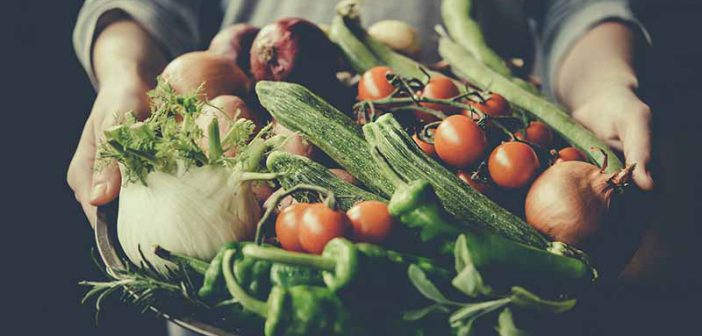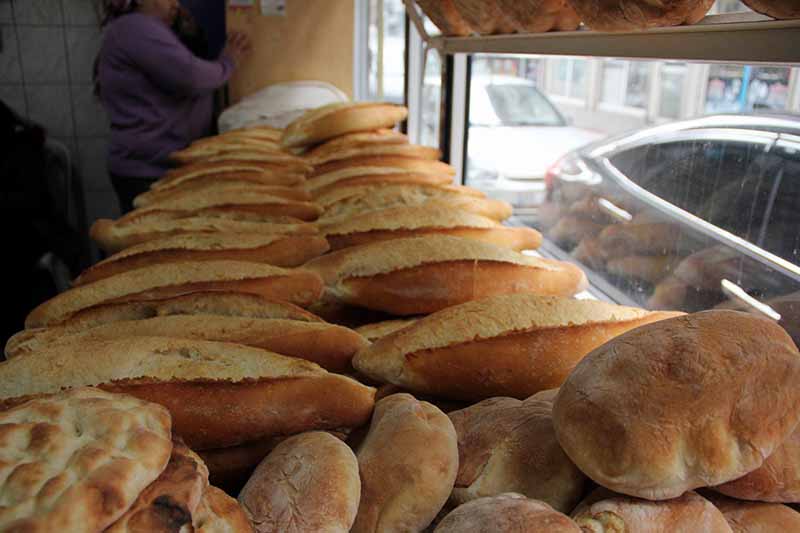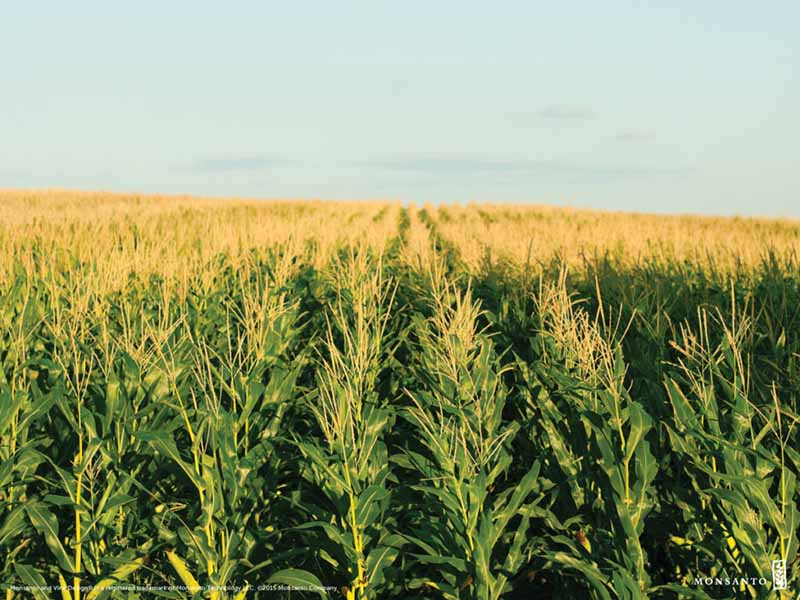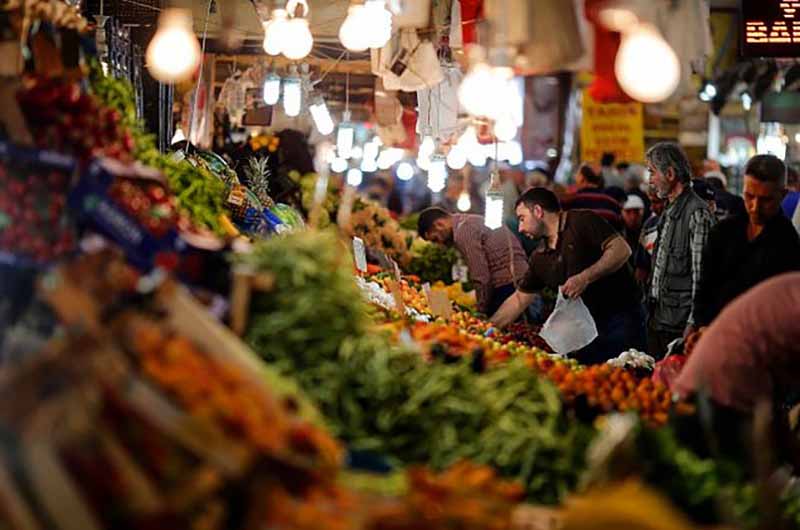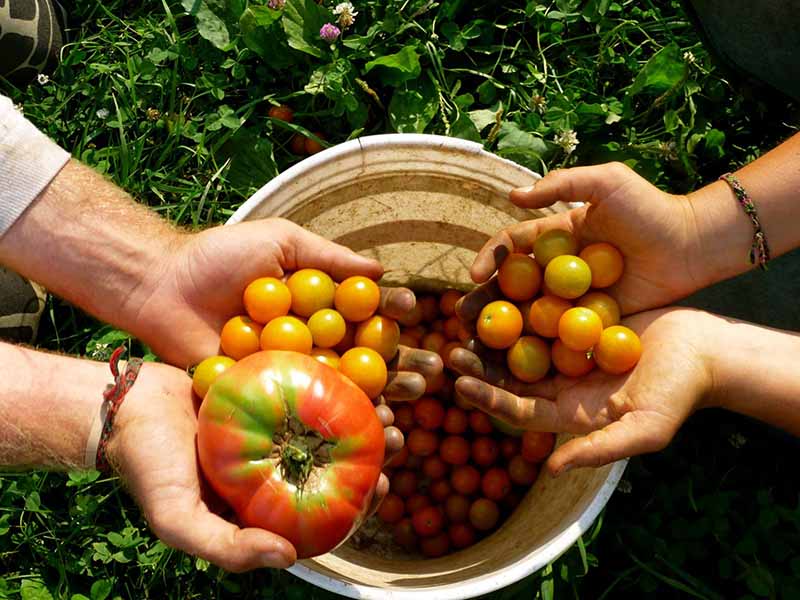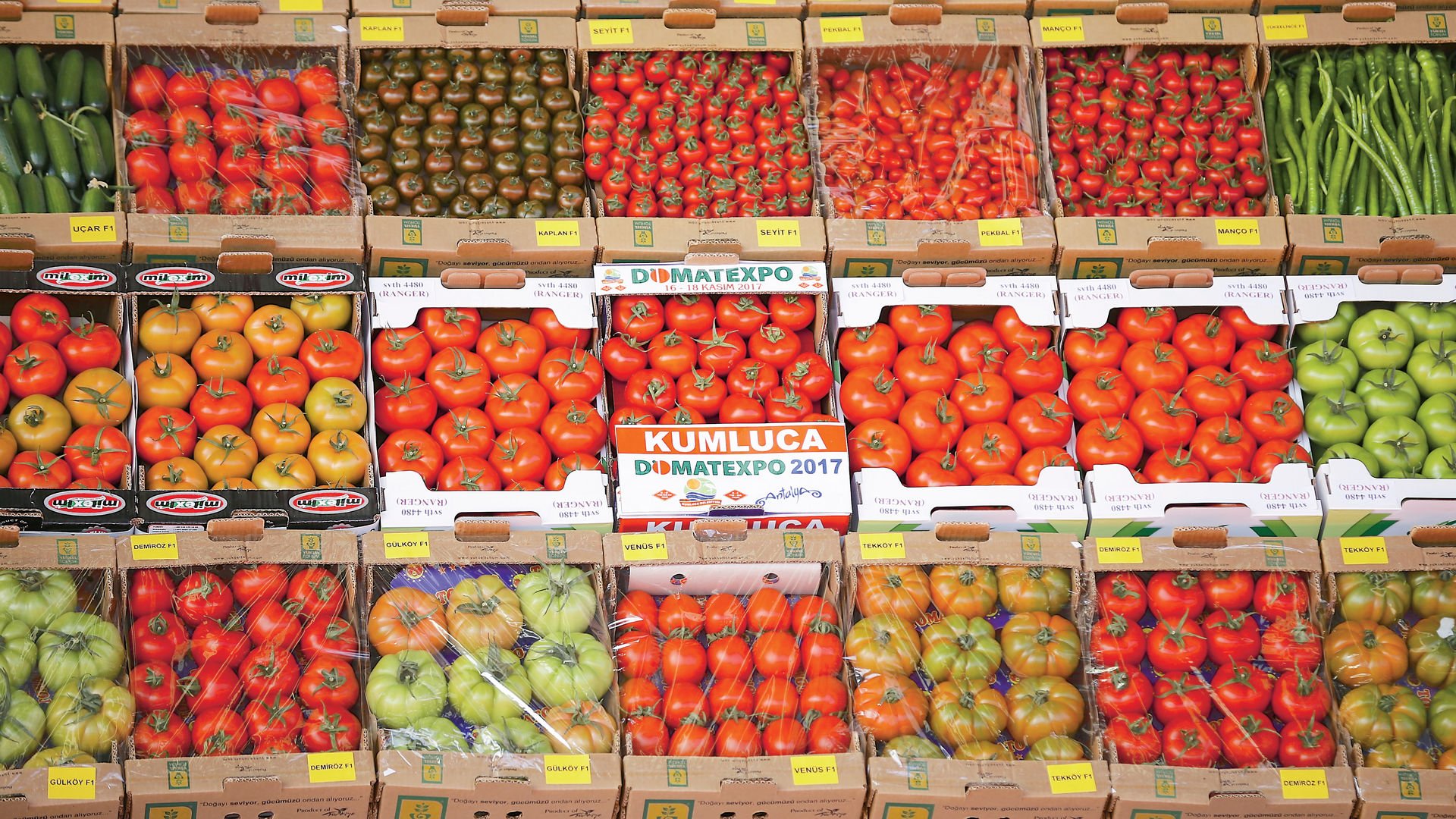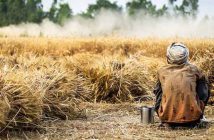1. The commonality of food and the food system
In today’s world, the nutrition underlying the vital activity of living things appears as a ‘food problem’. This problem, formed and defined by sufficiency, sustainability, mass starvation and slaughter throughout history, constitutes an important part in reproducing inequalities and injustices in the contemporary capitalist world. Today the issue of food is discussed in a variety of forms. From agricultural production to land, from products on the market shelf to the table, from packaging through labeling to recertification, numerous topics have been considered in relation to ‘food’.
Taking nutrition simply as the means to fulfill nutritional needs in order to performing physical functions would be inadequate. The broader definition of nutrition as the means to protect and recuperate health and supply living beings with power and energy is an essential part of the right to live. Thus, nutrition essentially must be considered along with healthy nutrition, and healthy nutrition must be considered along with nourishment and healthy food.
Healthy food when defined as a necessity for all, makes possible considering food as commons. However, this possibility does not easily appear prima facie. Ultimately, the food phenomena taking place within the extensive relations such as production, processing, distribution, and consumption, includes property relations, commodification, trade and consumption. On the other hand, food is determined by its use-value; it nourishes, feeds and is consumed. In this wider context, the primary condition to considering food as part of the commons is not simply seeing it as an object of consumption. Rather, it is a broader account of food that considers all the relations passed through during the commodification process (Akbulut, 2015). From this standpoint, the thing referred to as ‘food’ is a process. To understand how the process became established and meaningful within social relations, one must take into account the socio-political relations embedded within every particular food product.
We can understand the commonality of food as the relations that enable us to recognize food as a process, and in which agents take part (formed). Therefore, the production, processing, distribution and consumption processes should be considered as a whole – i.e. as a food system. Problematizing the food system, namely all the relations and agents occurring in the context of food, allows us to grasp the commonality of food. Furthermore, in this context, we can see and understand the commoning possibilities and experiences that rise in contrast to the corporatization and commodification relations taking place in the food system.
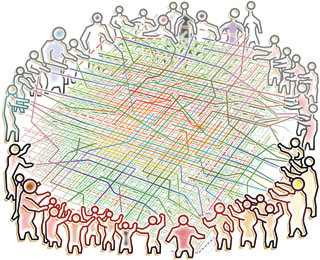 Commons presume relations that belong to nobody, which implies being external to property relations. Here, common is something that belongs to everyone and, therefore, something that belongs to nobody (Adaman, Akbulut and Kocagöz, 2017). Since the agricultural structure depends on land ownership and sovereignty of corporations, it is hard to grasp the commonality of food without following commoning opportunities, such as processes, experiences and capabilities that define food as for-all (Akçay and Kocagöz, 2018). In this sense, it is possible to say that determining commoning aspects and constituent agents of food is much harder to grasp than the commonality of a river, a forest or knowledge. Indeed, it is essential to have a relational approach regarding food commons (See, Adaman, Akbulut, and Kocagöz, 2017; Akçay and Kocagöz, 2018).
Commons presume relations that belong to nobody, which implies being external to property relations. Here, common is something that belongs to everyone and, therefore, something that belongs to nobody (Adaman, Akbulut and Kocagöz, 2017). Since the agricultural structure depends on land ownership and sovereignty of corporations, it is hard to grasp the commonality of food without following commoning opportunities, such as processes, experiences and capabilities that define food as for-all (Akçay and Kocagöz, 2018). In this sense, it is possible to say that determining commoning aspects and constituent agents of food is much harder to grasp than the commonality of a river, a forest or knowledge. Indeed, it is essential to have a relational approach regarding food commons (See, Adaman, Akbulut, and Kocagöz, 2017; Akçay and Kocagöz, 2018).
This relationality, the relations included within the food process, allows us to discuss the politics of the commons. For, on one hand, the commonality of food requires the definition of food itself as a common, namely, the proposition that argues food for-all, and, on the other hand, it allows us to think about the commonality of the relations that occur at different stages of the food process. If we remember that there are various layers to the politics of the commons, such as defending, reclaiming and reinventing commons, then a standpoint that allows us to examine these different layers also requires taking into account the relations of the commoning practices that arise by means of agency.
So why is defining food as a common so important? First, if we want to think of an alternative for the existing food system, we must actualize this thought as a criticism of the existing system. For this, counter to corporate logic, the commons approach is perfectly appropriate. Precisely on the condition of for-all, food can be considered an emancipation potential for subjects. Second, defining food as commons suggests a basis for political framework over the food system. This basis for creating alternatives is possible only by the correct definition of subjects, and determining that actors can meet in what kind of alliances.
The food system expresses the formation and relations of subjects as food producers, processors, distributors and consumers/users. The dominant food system in the contemporary world has been shaped around the governmentality of agro-food corporations and profit-oriented corporation logic. Having worldwide domination, these corporations organize and manage production, processing, distribution and consumption of food with the profit-oriented logic. Correspondingly, they subject these relations to market rationality based on profit maximization. We can name this system the industrial food system or corporate food regime.
Formation of the food system according to profit maximization contradicts the fundamental function of food, which is the basis of nourishment. From seeds to table, the entire process and all the agents included are forced into subordination to profit maximization and the relations of these agents come up against the commodification processes. Thus, all agents involved in agricultural structures are subordinated to laws of full oppression: the rural commons are enclosed; the processing institutions become more privatized and financialized; the food supply becomes commodified; and food users are segregated and subjectivized. [1]
The commonality of food or a common food politics requires the projection of a line grasping the totality of these processes, defining its agents and discussing which agents in which conditions might engage to the politics of the commons. Every particular agent is formed in its own context, depending on other relations and is included in the food system. From this standpoint, circumstances in which agents have the right to comment on the food system, their direct participation and decisiveness in the management processes of the food system, i.e. food sovereignty, could be seen as the basis of the food politics of the commons.
2. Origins of the food problem in Turkey
a. Agrarian change
Even if its geographical position is problematic, at the end of the 1990s Turkey was accepted as the last peasant country within Europe and the Middle East (Hobsbawn, 2006). Turkey could farm for its domestic market, and could export products such as hazelnuts, tea, cotton, fruit, and vegetables. It was always possible to find plentiful fresh fruit and vegetables; the home produced legume was taking its place on the shelf. Small farmers, who constituted the largest sector of the agricultural structure, could sell their goods by means of state-led cooperatives; they were motivated to continue farming.
Certainly, this scene does not mean that agriculture in Turkey was running perfectly or that there was not a food problem. Having been adopted after the Second World War within the scope of the Marshall Plan, ‘green revolution’ was a critical moment for tracking the structural transformation of agriculture in Turkey. With this process in agriculture, mechanization, the development of industry-oriented production processes, rendering small scale farming dependent on the food market and the takeover of the monoculture [2] production system that creates uniform production patterns in agriculture, has been accelerated and has become an intrinsic fact. In this respect, the modernization process of agriculture in Turkey can be seen as the formation of the capitalist market and the integration of it to the global market.[3]
The monoculture-based agricultural pattern meant small-scale farmers who could not compete in the market leaving farming, and giving medium and large-scale agriculture corporations a greater share of the market. As the peasants have left farming, the proletarianization of the agriculture has accelerated, and new forms of labor such as seasonal work and contract-farming have become more dominant in the agricultural structure (Ulukan, 2009). In sum, agriculture depending on market relations became determined by the agro-business model in which a number of agro-food corporations have a say. The supply, processing and selling of food by these corporations has brought about the breakdown of the relations between producers and users, and made the production process subject to the market. Groceries, greengrocers, consumer cooperatives and individual/family food supply networks were rapidly yielding to supermarkets. In other words, supermarketization (Keyder and Yenal, 2013) confronted us as another face of agricultural corporatization in the cities; determining urban consumption relations. In brief, this transformation that took place in the food production process brought about new forms of agents and new forms of relations between agents. In contemporary Turkey, these new relations and forms of relations constitute the basis of the food problem.
b. Food supply
Food supply, in terms of food systems, refers to a dynamic that has bilateral effects. On the one hand, supply relations formed in the supermarketization axis creates supply relations such as wholesale market-hall owning, wholesaling, commerce, small scale industry and processing. On the other hand, it has effects on behalf of the corporatization of agriculture and the formation of agricultural production according to the needs of corporations and the market. In this respect, the food supply issue itself is at the heart of the system as a network that bounds the two sides of the food system.
From the point of view of the producers, the importance of the food supply is based on how their products are used, that is, who supplies their products. Until the beginning of the 2000s, state funded and led agricultural cooperatives, unions or government agencies were the leading establishments that supplied the farming products. For example, in cereals, corn and rough rice TMO (Agricultural Products Office), in hazelnuts FİSKOBİRLİK, in tea ÇAYKUR, in olives TARİŞ and MARMARABİRLİK, in tobacco TEKEL, in meat, fish and dairy products EBK (meat and fish authority, or ESK as a rename), in beet PANKOBİRLİK. On the one hand, these institutions formed a public support basis by directly purchasing products from producers. On the other hand, they provided ‘public safety’ for food products through using their product processing capacity. Thus, producers had the support of the public guarantee that they needed to continue agricultural production, and food supply was provided to directly to society by cooperatives. It is necessary to emphasize that these cooperatives were under governmental control; they did not have democratic structures and they could not act autonomously of government policies.
At the beginning of the 2000s, ARIP (Agricultural Reform Implementation Project) prepared by the IMF and World Bank, had caused structural changes in Turkey’s food system. On the one hand, the pattern of agricultural support was reorganized, and on the other hand, in accordance with free trade policies, agricultural production and supply cooperatives were disbanded and incorporated (Aysu, 2014; 2015). Marketization of the food system can be seen as the pressure on producers to transform themselves into a kind of rural entrepreneur (Keyder and Yenal, 2013). In the face of a process in which farmers have to offer their product to market themselves, they have had to deal with the following conditions that constitute product stock market: the necessity of adapting to a market constituting tradesmen, suppliers and food trends. Either producers would locate themselves in the market as entrepreneurs who adapt themselves to new forms of neoliberal existence, or they would not succumb to the pressures of the rationality of the market and would leave the rural area (ibid).
‘Withdrawal’ of the ‘public’ has caused the prominence of ‘mediator’ agents in the food system who undertake the distribution and marketing costs but who do not take part in the production and consumption phases. In this process, both the farmer, who has a problem in accessing the market, and the consumer lose. For mediator, trade is a sector in which the food processing industry, the large scale logistics sector, wholesale market halls, retailer merchants, supermarkets and small retailers take part; and the relations into which agents in this sector enter with agro-food corporations allow these agents to become powerful and dominant in the agro-food system.
The market process, determined by production costs, logistics, problems accessing the market, consumption habits, etc., requires the transformation of producers into agents who are then in the competition. Therefore, producers must find a form of existence that raises productivity, reduces production costs and minimizes logistics costs in order to regulate their domestic consumption habits. This neoliberal governmentality (Dardot and Laval, 2012) requires agents to form themselves into corporations, become entrepreneurs and meet market needs in their own way; thus, ‘survive’. The farmers producing in the villages are not safe from this condition. Today, the new farming model is the entrepreneur farmer. The possibility of farmers who do not shape their concerns according to market dynamics to survive lessens day by day.
c. A consumer who becomes an agent
This market mechanism brings us the need for ‘real’, ‘genuine’, ‘organic’, ‘healthy’, ‘nutritious’ food, which is another basis of the food problem. The unsecured food products has also brought into being a process that encumbers the consumer in accessing healthy food. The proliferation of problems caused by malnutrition, filling shelves with junk food that has little nutritious value increases the issue of the adulteration of food products implied in the question about the definition of the food.
Put simply, urban dwellers who have higher education have an awareness of urban, ecology and gastronomy problems. Their quest for healthy food is important for making healthy food a a public demand, and developing awareness knowledge of food. On the one hand, this knowledge has led to the rise of the ‘conscious consumer’” and on the other, leads to the development of a market aimed at the needs of this category and the absorption of these needs in market relations. Thus, products labelled organic, and expressions such as natural and rural products appeared in the market. [4]
Development in communication technologies and the prevalence of social media have led to new forms of intermediate traders, who see establishing a connection between rural and urban areas by means of food as a kind of entrepreneurship: local internet sites selling 100 percent natural products; the logistic/naturalist/gourmet enterprises supplying the best products all over the Turkey; natural production farms; boutique businesses supplying direct from farm to table; neighborhood organic grocers; organic restaurants, cafes, associations, activities, etc.
Paying higher prices, those sections of society that have higher incomes, however, continue to access healthy, nutritious, delicious and locally produced food products through the market. Those sections that are still connected to rural areas continue to supply food in informal ways through their non-formal family relations. Nevertheless, the majority, having already drifted away from rural areas and not having high incomes and therefore little purchasing power, have a food security problem and have to access supermarkets, organic groceries, websites developed under the rationality of the market or producers they know. They have to choose from these various options themselves; they have to become agents. To put it another way, a large segment of consumers establish their agency in the market with each product they purchase.
In these circumstances, it is necessary to note that the particular decisions that depend on awareness, conscious consumption or attempts made by goodwill are extremely partial. It is important to enumerate the reasons for this. First, consumption is eventually one part of the four sectioned cycle of the food system. As mentioned above, each part of the food system (production, processing, distribution, consumption) has the capacity to effect and to alter the other parts. However, it is important to note that this capacity is limited and it causes only partial and slow transformations overall. Second, the dissolution of consumption habits in an individual way refers to a situation that weakens the power of consumers in the decision making processes. For the decision determining the product on the shelf and the final user is far beyond simply being a momentary issue. Each part of the production, processing, distribution, consumption relations that cover the food system effects the quality of this decision. Third, unless public policies are developed that take in the food system in its entirety, the frame of consumption practices will be limited by the decision practices of the corporate food system. These decision practices within the injustice class dynamics of the corporate food regime and reproduce the system at each moment.
In conclusion, these transformations taking place in the various phases of the food system have created a situation where the agents in the system, as entrepreneurs, are subject to market logic, and the large scale corporations are the actual winners in this process. Certainly, the corporate food system aimed at profit maximization prioritizes the profits of the agro-food corporations rather than society’s access to healthy and nutritious food. It is that dynamic that underlies the food problem in Turkey.
3. Common food policies
Up to this point, the corporate food system, which I have attempted to briefly depict, is involved in the process from seed to table with the construction of the agents mentioned above. This system is a model that reinforces the class layers and inequalities of society, includes the agents only as market players, therefore, excluding them from participation in making public policies, and means the sovereignty of corporations over food. The commodification process of food, in the first place, starts with seed-land and ends with end users decisions in the market. Common food policy requires following thedynamics of these very agents, their resistance to the system and their commoning practices, which can be a standpoint to understand an alternative policy over food.
a. Food sovereignty
Common food policies can only be constructed based on concrete relations and the activities of agents formed in these relations. For these policies it is necessary that the genuine agents be determinant, produce policy and focus on developing mechanisms that will enable the policies that are developed. Only a system in which organized agents settle their own food policy, from production to consumption, through participatory mechanisms can create the commoning of the food.
La Via Campensina [5], in its 2nd General Conference in 1996, developed the food sovereignty approach as an alternative to ‘food security’, and which the United Nations’ FAO (Food and Agriculture Organization) supported and suggested governments to adopt. Remarking that the concept of food security is a limited approach built in the agro-business context and does not take into account the producers and their conditions, La Via Campesina developed food sovereignty as a model in which small farmers and peasants are at the center of the production process. The food system would be designed for the benefits of producers and consumers, putting food producers and consumers at the heart of the system. This point of view suggests centralizing production conditions of the food that is excluded by the food security concept. Problems such as access to land, seed, biodiversity, use of and access to grazing lands, forests and rivers, using agro-ecological methods are of central importance for peasant farming. Thus, they should be defined as the principal factors of the food problem.
Taking its lead from La Via Campensina, Nyeleni Food Sovereignty Forum, which took place at the Nyeleni town of Mali in 2007, planted the seed of a global movement by extending the discussion of food sovereignty to all agents of the food system. [6] In this forum, the global principles of food sovereignty were defined, agro-business and industrial food system were clearly opposed and the food sovereignty struggle was defined as a social movement. The six pillars of food sovereignty determined by this forum are as follows:
2007 yılında Mali’nin Nyeleni kasabasında La Via Campesina öncülüğünde gerçekleşen Nyeleni Gıda  Egemenliği Forumu, gıda egemenliği tartışmasını gıda sisteminin tüm aktörlerine doğru genişleterek küresel bir hareketin tohumlarını atmıştır. Gıda egemenliğinin küresel ilkeleri belirlenmiş, şirket tarımına, endüstriyel gıda sistemine açıkça karşı çıkılmış ve gıda egemenliği mücadelesi toplumsal bir hareket olarak tanımlanmıştır. Bu forumda gıda egemenliğinin altı prensibi şu şekilde belirlenmiştir (aktaran: Kocagöz, 2018):
Egemenliği Forumu, gıda egemenliği tartışmasını gıda sisteminin tüm aktörlerine doğru genişleterek küresel bir hareketin tohumlarını atmıştır. Gıda egemenliğinin küresel ilkeleri belirlenmiş, şirket tarımına, endüstriyel gıda sistemine açıkça karşı çıkılmış ve gıda egemenliği mücadelesi toplumsal bir hareket olarak tanımlanmıştır. Bu forumda gıda egemenliğinin altı prensibi şu şekilde belirlenmiştir (aktaran: Kocagöz, 2018):
- Focuses on Food for People: Food sovereignty puts people, including those who are hungry, under occupation, in conflict zones and marginalized, at the centre of food, agriculture, livestock and fisheries policies, ensuring sufficient, healthy and culturally appropriate food for all individuals, peoples and communities; and rejects the proposition that food is just another commodity or component for international agri-business.
- Values Food Providers: Food sovereignty values and supports the contributions, and respects the rights, of women and men, peasants and small scale family farmers, pastoralists, artisanal fisherfolk, forest dwellers, indigenous peoples and agricultural and fisheries workers, including migrants, who cultivate, grow, harvest and process food; and rejects those policies, actions and programmes that undervalue them, threatens their livelihoods and eliminates them.
- Localizes Food Systems: Food sovereignty brings food providers and consumers closer together; puts providers and consumers at the centre of decision-making on food issues; protects food providers from the dumping of food and food aid in local markets; protects consumers from poor quality and unhealthy food, inappropriate food aid and food tainted with genetically modified organisms; and resists governance structures, agreements and practices that depend on and promote unsustainable and inequitable international trade and gives power to remote and unaccountable corporations.
- Puts Control Locally: Food sovereignty places control over territory, land, grazing, water, seeds, livestock and fish populations on local food providers and respects their rights. They can use and share them in socially and environmentally sustainable ways that conserve diversity; it recognizes that local territories often cross geopolitical borders and ensures the right of local communities to inhabit and use their territories; it promotes positive interaction between food providers in different regions and territories and from different sectors that helps resolve internal conflicts or conflicts with local and national authorities; and rejects the privatization of natural resources through laws, commercial contracts and intellectual property rights regimes.
- Builds Knowledge and Skills: Food sovereignty builds on the skills and local knowledge of food providers and their local organizations that conserve, develop and manage localized food production and harvesting systems, developing appropriate research systems to support this and passing on this wisdom to future generations; and rejects technologies that undermine, threaten or contaminate these, e.g. genetic engineering.
- Works with Nature: Food sovereignty uses the contributions of nature in diverse, low external input agroecological production and harvesting methods that maximize the contribution of ecosystems and improve resilience and adaptation, especially in the face of climate change; it seeks to heal the planet so that the planet may heal us; and rejects methods that harm beneficial ecosystem functions that depend on energy intensive monocultures and livestock factories, destructive fishing practices and other industrialized production methods that damage the environment and contribute to global warming.[7]
The food sovereignty paradigm stands on the side of producers’ against the agro-business and the corporate food system and expands to the other segments of society. It is significant in both its formation and development. On one hand, being the self-organization of food producers as ‘people of the land’, the formation and organization of La Via Campesina places the producers and production problems at the heart of the food system (Martinez-Torres and Rosset, 2010). On the other hand, the food sovereignty strategically offers a ground for cooperating with the other sections of society (See, Kocagöz 2016a, 2016b). Therefore, for all agents included in the system, a practical basis and paradigm of producing and organizing common food policies has been defined.
Peasant agriculture and agroecology approaches defended by La Via Campesina appear as an agricultural model that secures producer peasants’ (and/or small farmers’) access to land, compatible with nature, labor, and the land used by peasants with reference to the use-value of common assets such as springs, forests, grazing land, plateaus, etc. Today, small farmers’ fights for their land and struggles for the right to access the land are leading problems for the peasantry. In particular, global land-grabbing (Borras and Franco, 2013) leads to fundamental transformations in agricultural structures; small farmers are thrown off their land by extra-economic means (Glassman 2017) in their fight with corporations, and the struggle of the land is the primary issue in small farmers’ struggles. In Turkey, this situation occurs frequently regarding energy and development projects such as hydroelectric plants (HEP), wind power plants (WPP), dams, mines, and geothermal power plants (GPP) etc. Peasants whose lands are ‘expropriated’ and the rights of use are passed to the corporations start to take action in order to defend the commons. The primary demand of the rural-based social movements in Latin America is the modification of the large scale land owning system from the colonial period and the fair distribution of the lands around complete agrarian reform. The Landless Workers’ Movement, MST (Movimento dos Trabalholders Rurais Sem Terra), focuses on access to the land and agrarian reform as their primary aim. MST arose from the struggles of the landless peasants, defined by the movement as landless rural workers, and aims at gaining the right of access to the land and to provide access to the land for peasants. Their most radical action was the occupation of the latifundos. Defining themselves as socialists, MST distributes land fairly between landless peasants in places where there is agrarian reform and allows them to have their own lands.
In such conjuncture, the struggles of small farmers underlying the food production for access to the land 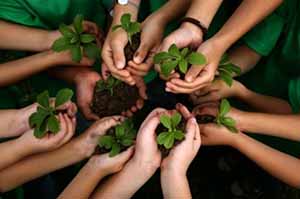 must be seen as a very fundamental element of food sovereignty as the struggle of production is also the defense of agroecology. MST firstly establishes camps in the lands they occupy and then transforms these places into a life space and begins agricultural production. Products are sold by cooperatives. If the occupation process is successful and the Ministry of Agrarian Reform accepts giving land to the landless peasants, then they settle in these lands and begin to establish a new life space. These settlements are organized around the collective organization and production principles of MST. Again, producers of the MST organize fairs in their areas and have been organizing the National Agrarian Reform Fair for the last three years. These fairs argue for the necessity of agrarian reform, and the importance of producers’ peasant agriculture, as well as providing opportunities for consumers to meet farmers from whom they can directly buy products. Thus, through self-organization farmers who make their own decisions on what to produce can meet with the consumers and supply them with healthy and nutritious food.
must be seen as a very fundamental element of food sovereignty as the struggle of production is also the defense of agroecology. MST firstly establishes camps in the lands they occupy and then transforms these places into a life space and begins agricultural production. Products are sold by cooperatives. If the occupation process is successful and the Ministry of Agrarian Reform accepts giving land to the landless peasants, then they settle in these lands and begin to establish a new life space. These settlements are organized around the collective organization and production principles of MST. Again, producers of the MST organize fairs in their areas and have been organizing the National Agrarian Reform Fair for the last three years. These fairs argue for the necessity of agrarian reform, and the importance of producers’ peasant agriculture, as well as providing opportunities for consumers to meet farmers from whom they can directly buy products. Thus, through self-organization farmers who make their own decisions on what to produce can meet with the consumers and supply them with healthy and nutritious food.
After the parliamentary coup in 2016 in Brazil, one of the leaders of the MST, João Pedro Stédile, explained the connection between the Temer government and agri-business, proving the government’s actions were in favor of these corporations. Based on this conjuncture analysis, Stédile proposed that all products of agroecologial production were anti-Temer. As Stedile states, the coup was paid for by the profits of the agricultural corporations and proved the necessity of developing a solution to the food problem that encompasses the whole of society. Thus, every moment in which food sovereignty occurs expresses the democratic will against against the coup, and commoning of food as an alternative to the corporate food system. Certainly, it is important to note that this anecdote depends on the unique conditions of Brazil (Kocagöz, 2016c).
To sum up, we can note that food sovereignty takes food as a political issue, defines agents and places them at the heart of the food system. We can say it grants, from small farmers to collective farm practices to these agents to take place in the common organizations in the process, to connect each other, to develop approaches preceding cooperative relations rather than corporate ones, to produce local, national, regional, and global policies in order for commoning the food and defending these policies to be performed by the public. In this context, food sovereignty underlies the commoning of food and creating food policies for all and determines the issue of the food right and food justice as class issues (Allen and Smolski, 2016).
b. Food initiatives in Turkey
For food sovereignty to be settled, it is necessary that the agents of the food system be organized and connected to each other. On one hand, each of these organizations have been looking for ways to define their own rights and to develop policy proposals to defend these rights. This is empowered by building alliances with other actors to construct a common food policy. On the other hand, they are looking for an actual commoning of food and ways of building food sovereignty here and now.
By the early 2000s in Turkey, farmers had decided to establish union organizations and to defend their
agricultural production rights against the process described above. Tüm Üretici Köylüler Sendikası (Tüm-Köy- SEN, All Producer Peasant’s Union) aims to bring all producer peasants around a single union structure, and Çiftçi Sendikaları Konfederasyonu (Çiftçi- SEN, Confederation of Small Farmers’ Unions), confederated in 2008, foregrounds product-based unionism. These two organizations attempt to generate a farmer-based policy as a challenge to marketization in agriculture and neoliberal politicies. Çiftçi-SEN, as a member of La Via Campesina and a participant in the establishment of European Via Campesima Coordination in 2009, is an important cornerstone for the recognition and construction of the food sovereignty struggle in Turkey.[8]
Again in the early 2000s, the initiative to regulate GMOs made possible the establishment of GDO Karşıtı Platform (Anti-GMO Platform) by bringing together different segments of society. This platform, which incorporates a large segment from farmers to engineers and from consumer organizations to political parties, is an important example of the alliances between farmers and urban dwellers. Thus, agriculture and food together have become a collective struggle of both urban and peasant sections of society and been defended as a common.
In their quest for food security, consumers’ individual choices certainly do not result in their involvement in the food system. Associations, cooperatives, food communities, food networks, initiatives established by consumers and semi-producers (türetici)[9] have been operating for a considerable amount of time in Turkey as organizations that bring together people who do not accept the existing food system and want to see change.[10] As well as these, we should add the existence of various producer-consumer initiatives such as ecological markets, earth markets, joint-kitchens, consumer associations, and various urban gardens.[11]
Food communities and consumer cooperatives are, in fact, the actualization of food sovereignty. These initiatives deliver healthy and nutritious products to end-users by supplying them directly from producers without an intermediary. These initiatives are usually open to everyone’s participation and organized as democratic, non-hierarchical structures. They do not seek profit; therefore, it is not a matter of obtaining any rent from food. Food initiatives basically work with small farmers who engage in agroecology. They thus support the production right of small farmers and with this support contribute to their struggle to survive. The presence of such farmers, contacting and supporting them, shortens the distance between the urban and the rural, enabling a new form of relation that is participatory and contact-based (Aysu, 2015). Hence, we can say that these initiatives build food as a common by defending access to healthy and nutritious food for all.[12] Apart from these initiatives, it is possible to mention examples such as initiatives to support urban gardens under threat in İstanbul,[13] establishing and developing new agrarian urban gardens,[14] supporting the producers with the contribution of municipalities in the last agricultural production districts of Istanbul such as Şile and Silivri.[15]
One of the primary concerns of the current food system is the issue of logistics. The separation of urban and the rural zones as agricultural production/consumption zones, as has happened in Istanbul, has removed agriculture from the urban and made it possible for non-agricultural lands to become widespread. However, the spread of urban food production may bring about the localization of the food system, thus a decrease in logistics costs and in ecocide. The support of urban parks and urban cultivation areas would increase the contact between the producer and consumer, therefore decreasing the distance between them. This may be possible through the growth, expansion, diversification, and development of food initiatives.[16]
Finally, it is crucial to talk about the formations of people who have recently begun farming in the countryside that advocates and supports collective agricultural practices.[17] These collective practices matter both in terms of developing and expanding non-industrial means of agricultural experience, and of building agriculture as a collective practice.
c. Politics of commoning food
The question of commoning food requires that the formation of actors and the linkage between each of them be established and that actors should develop food sovereignty by building participatory and democratic mechanisms. For that, it is essential to build local, national, regional, and global food initiatives, strengthen and support existing food initiatives, establish links between different food initiatives, and build common grounds.
Commoning food requires crucially introducing resistance opportunities at all stages of the existing food system. Hence, it is crucial to deny the existing industrial-monocultural agriculture model but to defend agroecology and the peasant agriculture. For example, producer cooperatives, that were established by small and/or medium farmers in places such as Hopa, Devrek, Tire, Ovacık, Hozat, aim at both defending the rights of farmers defined-above and producing healthy food products. Thus, single farmers organize new types of relations on the common ground of the cooperative. Such an increase in farmer organizations can be considered as a core of organizing and joining more farmers engaged in ecological farming, as well as bringing together those who want to start farming and opening up organizational channels to establish a new agricultural model.
It is also important to increase the processing capacities of agricultural production cooperatives at the same time. For example, in opposition to ÇAYKUR and the other corporations, the Hopa Çay Kooperatifi’s (Hopa Tea Cooperative) ability to survive is its ability to turn wet tea (agricultural product) into dry tea (processing) and put it on the market through alternative channels. In the same way, the strengthening of the integrated facilities of Tire Süt Kooperatifi (Tire Milk Cooperative) and the development of a milk processing capacity makes it possible to reach more consumers. The agreement signed by Tire Süt Kooperatifi and the Izmir Municipality to deliver products to homes and schools in association with the Izmir Municipality can be seen as an important case in terms of the support given to such cooperatives by a public institution.
The kind of consumer-based food initiative mentioned above is a very important organization experience in terms of bringing consumers together and developing common practices to solve their common problems. Thus, the support for agroecology is becoming possible, as well as new urban organization practices, and the foundations for actors to construct an urban-based food politics are being laid. 2. Gıda Toplulukları Çalıştayı [Second Food Communities Workshop][18], organized by several food initiatives in 2017, and Şeker Fabrikalarının Özelleştirilmesi Bağlamında Gıda Egemenliği Atölyesi [Food Sovereignty Workshop Regarding the Privatization of Sugar Beet Factories] organized by Kadıköy Kooperatifi in 2018, could be thought as examples of such interventions helping to create grounds for producing common policies. Since these initiatives involve both producers and consumers and have developed horizontal and cohesive relations from the base up for sharing knowledge and policy production, they provide answers to the issue of how food commoning policies could be done.
While urban food initiatives are aimed at building an alternative to agro-food policies and supporting existing alternatives, they also have the ability to develop solutions to issues of how the urban zone should be organized, the possibilities of constructing alternative consumer relations, to find collective, lasting, and holistic solutions to social injustices that were stratified through food. In this way, it can be said that these initiatives have created a link between the urban-based and the rural-based labor movement and created the means to become part of the social movements. We can say that food initiatives are an important part of social movements because of their democratic structures, their wide connections and networks, and their tendency to construct solidarity and unity among different sections by problematizing food as a common.
Afterword: Four tactics
We can describe the strategy for commoning food and developing common food policies with four main tactics. The first tactic is producing a critical knowledge of the food system. Criticism of the corporate food system mandates the production of information about what healthy and nutritious food is and how to access it. Researchers, producers, and food initiatives contribute to the production of this knowledge together and in solidarity and strive for the publication of it. The second tactic is organizing food initiatives. Grass root organizing and collective farm practices in rural areas are the basis for this. As long as food initiatives can build common ground in the city, as mentioned above, there is potential for them to become an alternative.[19] The third tactic is that urban and rural initiatives collaborate and actually build food sovereignty. The building of an unmediated and direct system by organized producers and consumers, the dissemination, and socialization of this system, and the consolidation of solidarity relations today means the construction of another food system. This system will be a possible alternative to the corporate food system as long as it is socialized. The fourth tactic is the production of common food policies at the public level. A ‘food policy’ that the actors and initiatives build together will enable them to become part of the social struggle by gaining the ability to be a common food program for large communities.[20]
The politics of commoning food is based on the organization of food initiatives that identify food as a common, construct rhetoric on the public level, and the organization of networks that realize food sovereignty by directly commoning food. These networks today in Istanbul, in various cities of Turkey, in different countries, regions, and finally across the globe are haunting like a spectre. Some of them remain at the forefront, some of them are slow and stumbling, but they are involved in endless searching and construction. We, of course, know this spectre, which will be commoning food, from somewhere else, do we not?
Notes
[1] For an extensive critique of the existing food system see Aysu (2015).
[2] Monocultural agriculture is the formation of agricultural production with a prominent product by using it in a region as a base. Therefore, agricultural production becomes industry-oriented; it strays away from its main purpose.
[3] It is impossible to discuss here the general structure of this process. In order to follow the story of the transformation of agriculture in Turkey see Aysu (2014), Köymen (1998), Keyder and Yenal (2013), Pamuk and Toprak (1988), Oral (2013) and Aydın (2017).
[4] In today’s Turkey, ‘organic’ refers to the certificate that defines an agricultural model that does not use chemical ingredients and fulfils certain standards, and defines products of this model. Entering a grocer you look at the certificate in order to understand whether a product is organic or not. The certificate is the mediator of the conversation between the producer and the consumer. Yet, it is interesting to note that the certification process is performed by a certain corporation rather than the public, and producers pay significant costs to attain this certificate (Keyder and Yenal, 2013). Thus, it is necessary to note that today organic agriculture is based on the corporate agriculture model.
[5] Having 182 organizations as members from 81 countries, La Via Campesina is a global and institutionalized social movement gathering together more than 200,000 farmers, landless rural workers, peasants, nomads, and locals. La Via Campensina aims to develop opposition policies for any level of the corporate food system from land to global institutions, capitalism and patriarchy, defending those segments of the society it represents. For more information see Kocagöz (2018); Kocagöz (2017a); La Via Campensina (2015); Aysu (2009).
[6] https://nyeleni.org/spip.php?article290
[7] See: https://nyeleni.org/DOWNLOADS/Nyelni_EN.pdf
[8] For more detailed information on the establishment process and the work of Çiftçi- SEN see Aysu (2017).
[9] This word is a combination of üretici (producer) and tüketici (consumer) that implies taking part in an organized consumer act productive of an alternative food system.
[10] Buğday Derneği (Wheat Association), the most rooted of them all, dates back to the 1990s. Buğday Hareketi (Wheat Movement), which continues its work as an association in 2002 has contributed significantly by laying the foundations of ecological awareness and different ecological solutions in Turkey. Again, Yeryüzü Derneği, which does pioneering work regarding ecological practices and food communities, was established in 2009. The establishment of Boğaziçi Mensupları Tüketim Kooperatifi -BÜKOOP (Boğaziçi’s Members Consumer Cooperative), which started off with the perspective of food sovereignty within consumer groups, dates back to 2009.
[11] I should note that from this point, I will focus on Istanbul-based initiatives. Hence, I need to say that these kinds of initiatives exist and spread to cities such as Ankara, İzmir, Eskişehir, Diyarbakır, Mersin, Antalya, etc. Also, I would like to remind you that, apart from the initiatives mentioned, food sovereignty practices, e.g. seed barter networks, exist. It is beyond the scope of this article to go into a detailed discussion on all these.
[12] For a variety of food communities in Turkey see http://gidatopluluklari.org. Aside from BÜKOOP, mentioned above, it is possible to mention Kadıköy Kooperatifi, Anadolu’da Yaşam Tüketim Kooperatifi, Yeni Hasat Tüketim Kooperatifi, Beşiktaş Kooperatifi Girişimi, Koşuyolu Kooperatifi Girişimi, Şişli Kooperatifi Girişimi as pursuing actively their works.
[13] Direnen Üretici Tüketici Kolektifi -DÜRTÜK is one of the most recent examples of this. DÜRTÜK is a food initiative that makes direct purchases from urban gardens that are currently under the threat of destruction. The participants of the initiatives meet and chat on shopping days organized by volunteers to buy products from these gardens; the right of production of urban gardens that resist destruction is defended, while the ways of organizing the consumers around the food are developed.
[14] The Kent Bahçeleri project, conducted by Yeryüzü Derneği, is an example of this. In addition Moda Gezi Bostanı, which was created after Gezi revolt in the Caferağa district of Kadıköy is an important example even though it is not in operation at the moment.
[15] An example of this is the Tohum Takas Şenlikleri (Seed Exchange Festivals) organized in Silivri and Şile. This type of seed-bartering practice is a resistance strategy developed to protect and share local seeds against the Seed Act of 2004, which prohibits farmers from selling seeds. In some festivals only exchanges are made, in others relations are established and networks are organized so that barter groups follow and support each other.
[16] As a contradictory example, it is necessary to mention here the Istanbul Zapatista Coffee Collective. It is in direct relation with the local Zapatista peasant cooperatives of coffee produced in Mexico, bringing coffee to Turkey, and by building an alternative network takes over the distribution of coffee. The Coffee Collective experience is quite influential, since international trade practices such as fair trade etc. are not common among food initiatives in Turkey. This non-profit collective employs pricing policies that meet only the labor involved and distributes the products at a fixed price.
[17] The farms of Refikler Farm in Fethiye, Zeytinli Ecological Common Life Community in Zeytinli, Earth Eco Village in Pamukova, İmece House in Menemen etc., are important examples of developing alternative living and agricultural practices.
[18] For a detailed evaluation of this issue see Kocagöz (2017b).
[19] For characteristic properties of common food initiatives see Kocagöz (2017).
[20] For an actual example on this issue see Kolektif (2018).
References
Adaman, F., Akbulut, B. & Kocagöz, U. (Ed.) (2017). Herkesin Herkes İçin: Müşterekler Üzerine Eleştirel Bir Antoloji. İstanbul: Metis.
Akbulut, B. (2015). “Sofradaki Yemeğin Ötesi: Gıda Müşterekleri ve Feminizm”. Kültür ve Siyasette Feminist Yaklaşımlar. Issue 26.
Akçay, E. & Kocagöz, U. (2018). “Bir Rasyonaliye Olarak Müşterekleştirme”. Umut Kocagöz (Ed.) Felsefelogos, issue 68.
Allen, J. & Smolski, A. (2016). “Gıda Adaleti Sınıf Savaşıdır”. Trans. Caner Murat Doğançayır. Karasaban. Access: https://www.karasaban.net/gida-adaleti-sinif-savasidir-jason-allen-ve-andrew-smolski/
Aydın, Z. (2017). Çağdaş Tarım Sorunu. İstanbul: İmge.
Aysu, A. (2009). “Çiftçilerin Küresel Örgütü: La Via Campesina”. Bianet. Access: http://bianet.org/bianet/bianet/118931-ciftcilerin-kuresel-orgutu-la-via-campesina
Aysu, A. (2014). “Osmanlı’dan Cumhuriyete Devlet ve Tarım: yıkılış-kuruluş-çözülüş”. Aysu, A. & Kayaoğlu, M.S. (Ed.). Köylülükten Sonra Tarım. İstanbul: Epos.
Aysu, A. (2015). Gıda Krizi: Tarım, Ekoloji ve Egemenlik. İstanbul: Metis.
Aysu, A. (2016). “Brezilya, darbe, çiftçiler ve MST”. Karasaban. Access: https://www.karasaban.net/brezilya-darbe-ciftciler-ve-mst/
Aysu, A. (2017). “ÇİFTÇİ-SEN: Sendikal örgüte doğru”. Kayaoğlu, M. S. (Ed.) 2000’li Yıllarda Türkiye’de Sendikacılık: Zorluklar, Eğilimler, Olanaklar. Ankara: Epos.
Borras, J. S. & Franco, J. (2013). “Global Land Grabbing and Political Reactions ‘From Below’”. Third World Quarterly, 34.
Dardot, P. & Laval, C. (2012). Dünyanın Yeni Aklı. Çev. Işık Ergüden. İstanbul: İstanbul Bilgi Üniversitesi Yayınları
Glassman, J. (2017). “İlk Birikim, Mülksüzleştirerek Birikim ve “Ekonomi-dışı Araçlarla Birikim””. Adaman, F., Akbulut, B. ve Kocagöz, U. (Ed.) Herkesin Herkes İçin: Müşterekler Üzerine Eleştirel bir Antoloji. İstanbul: Metis.
Hobsbawm, E. (2006). Kısa 20. Yüzyıl: 1914-1991 Aşırılıklar Çağı. Çev. Yavuz Aloğan. İstanbul: Everest.
Keyder, Ç. & Yenal, Z. (2013). Bildiğimiz Tarımın Sonu: Küresel İktidar ve Köylülük. İstanbul: İletişim.
Kocagöz, U. (2016a). “Gıda Egemenliği: bir örgütlenme kavramı”. Karasaban. Access: https://www.karasaban.net/gida-egemenligi-bir-orgutlenme-kavrami/
Kocagöz, U. (2016b). “Ohal’de gıda egemenliği nasıl örgütlenir”. Karasaban. Access: https://www.karasaban.net/ohalde-gida-egemenligi-nasil-orgutlenebilir-umut-kocagoz/
Kocagöz, U. (2016c). “MST darbeye karşı toprak işgaline devam ediyor”. Karasaban. Access: https://www.karasaban.net/mst-darbeye-karsi-toprak-isgaline-devam-ediyor/
Kocagöz, U. (2017a) “Gezegeni köylüler kurtarabilir mi?”. Gaia Dergi. Access: https://gaiadergi.com/gezegeni-koyluler-kurtarabilir-mi/
Kocagöz, U. (2017b). ““Gıda sistemini biz değiştireceğiz”: 2. Gıda Toplulukları Çalıştayı üzerine”. Yeşil Gazete. Access: https://yesilgazete.org/blog/2017/12/11/gida-sistemini-biz-degistirecegiz-2-gida-topluluklari-calistayi-uzerine-umut-kocagoz/
Kocagöz, U. (2018) “Gıda sistemi, aktörler ve mücadele olanakları”. Karasaban. Access: https://www.karasaban.net/gida-sistemi-aktorler-ve-mucadele-olanaklari-umut-kocagoz/
Kolektif (2018). Halkın Gıda Politikası: Gıda Sistemimizi Dönüştürmek. Trans. Ekoloji Kolektifi Derneği. Özlüer, F. ve Kocagöz, U. (Ed.). Access: http://ekolojikolektifi.org/portfolio/halkin-gida-poiltikasi/
Köymen, O. (1998). “Cumhuriyet Döneminde Tarımsal Yapılar ve Tarım Politikaları”. Baydar, O. (Ed.). 75. Yılda Köylerden Şehirlere. Istanbul: Tarih Vakfı Yayınları.
La Via Campesina. (2015). La Via Campesina 20. Yaşında. Trans. Kolektif. Çiftçi Sendikaları Konfederasyonu.
Martínez-Torres, M. & Rosset, P. (2010). “La Via Campesina: the birth and evolution of a transnational social movement”. The Journal of Peasant Studies, vol 37.
Oral, N. (Ed.) (2013). Türkiye’de Tarımın Ekonomi Politiği. İstanbul: Notabene.
Pamuk, Ş. & Toprak, Z. (Ed.) (1988). Türkiye’de Tarımsal Yapılar. Ankara: Yurt.
Ulukan, U. (2009). Türkiye Tarımında Sözleşmeli Çiftçilik: Bursa Örneği. İstanbul: SAV.
Kaynak: Musterekler


